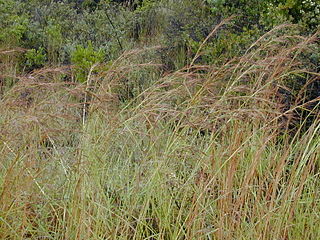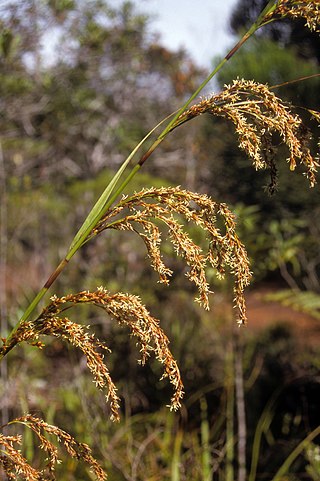
The Cyperaceae are a family of graminoid (grass-like), monocotyledonous flowering plants known as sedges. The family is large, with some 5,500 known species described in about 90 genera, the largest being the "true sedges" genus Carex with over 2,000 species.

Tragia is a genus of flowering plants in the spurge family, Euphorbiaceae. It is widespread across North and South America, Africa, the Arabian Peninsula, the Indian Subcontinent, northern Australia, and to various islands in the Caribbean and in the Indian Ocean.
Mapania is a genus of plants in the family Cyperaceae. It contains 100 species, distributed in tropical regions of Africa, India, southern China, Southeast Asia, New Guinea, Australia, Central America, northern South America, and various oceanic islands.

Mimusops is a genus of plants in the family Sapotaceae described as a genus by Linnaeus in 1753.

Uncinia is a genus of flowering plants in the family Cyperaceae, known as hook-sedges in Australia and as hook grasses or bastard grasses in New Zealand. The genus is characterised by the presence of a long hook formed by an extension of the rachilla, which is used to attach the fruit to passing animals (epizoochory), especially birds, and it is this feature which gives the genus its name, from the Latin uncinus, meaning a hook or barb.

Hyparrhenia is a genus of grasses. Many species are known commonly as thatching grass.

Kyllinga is genus of flowering plants in the sedge family known commonly as spikesedges. They are native to tropical and warm temperate areas of the world, especially tropical Africa. These sedges vary in morphology, growing to heights from 2.5 centimeters to a meter and sometimes lacking rhizomes. They are closely related to Cyperus species and sometimes treated as part of a more broadly circumscribed Cyperus.

Ficinia is a genus of tufted or rhizomatous sedges in the family Cyperaceae. There are around 70 recognised species in Africa, four species that occur in New Zealand and a single species Ficinia nodosa that occurs in Australia.

Stylochaeton is a genus of flowering plants in the family Araceae that is native to Africa. Stylochaeton are rhizomatous with hastate leaves. Flowering in this genus is said to be quite uncommon. Stylochaeton is the sole genus in the tribe Stylochaetoneae.

Sacciolepis is a genus of plants in the grass family. Cupscale grass is a common name for plants in this genus.
Fimbristylis polytrichoides is a species of fimbry known by the common name rusty sedge, native to east Africa, Madagascar, China, Southeast Asia, New Guinea and Australia. The plant is common along the coast line and estuaries of Australia. The flowers are a distinctive rusty brown color appearing on a single spikelet from May to July.

Microcoelia is a genus of orchids native to sub-Saharan Africa as well as to Madagascar and other islands of the Indian Ocean.
- Microcoelia aphylla(Thouars) Summerh. - from Kenya and Uganda south to KwaZulu-Natal, plus Madagascar, Mauritius and Réunion
- Microcoelia aurantiaca(Schltr.) Summerh. - Madagascar
- Microcoelia bispiculataL.Jonss. - Madagascar
- Microcoelia bulbocalcarataL.Jonss. - Príncipe, Cameroon, Gabon, Uganda, Rwanda
- Microcoelia caespitosa(Rolfe) Summerh. in J.Hutchinson & J.M.Dalziel - western and central Africa from Liberia to Zaïre and Uganda
- Microcoelia corallinaSummerh. - Tanzania, Mozambique, Malawi
- Microcoelia cornuta(Ridl.) Carlsward - Madagascar, Comoros
- Microcoelia decaryanaL.Jonss. - Madagascar
- Microcoelia dolichorhiza(Schltr.) Summerh. - Madagascar
- Microcoelia elliotii(Finet) Summerh. - Madagascar
- Microcoelia exilisLindl. - from Kenya and Uganda south to KwaZulu-Natal, plus Madagascar
- Microcoelia gilpinae(Rchb.f. & S.Moore) Summerh. - Madagascar
- Microcoelia globulosa(Hochst.) L.Jonss. - from Nigeria east to Eritrea, south to Angola and Zimbabwe
- Microcoelia hirschbergiiSummerh. - Zaïre, Zambia
- Microcoelia jonssoniiSzlach. & Olszewski - Central African Republic
- Microcoelia koehleri(Schltr.) Summerh. - from Nigeria to Tanzania, south to Zimbabwe
- Microcoelia konduensis(De Wild.) Summerh - western and central Africa
- Microcoelia leptostele(Summerh.) L.Jonss. - Central African Republic, Zaïre
- Microcoelia macrantha(H.Perrier) Summerh. - Madagascar
- Microcoelia macrorhynchia(Schltr.) Summerh. in J.Hutchinson & J.M.Dalziel - central Africa
- Microcoelia megalorrhiza(Rchb.f.) Summerh. - Kenya, Tanzania, Malawi
- Microcoelia microglossaSummerh. - central Africa
- Microcoelia moreauaeL.Jonss - Kenya, Tanzania, Zimbabwe
- Microcoelia nyungwensisL.Jonss. - Rwanda
- Microcoelia obovataSummerh. - from Kenya south to KwaZulu-Natal
- Microcoelia ornithocephalaP.J.Cribb - Malawi
- Microcoelia perrieri(Finet) Summerh. - Madagascar
- Microcoelia physophora(Rchb.f.) Summerh. - Kenya, Tanzania, Madagascar
- Microcoelia sanfordiiL.Jonss - Cameroon
- Microcoelia smithii(Rolfe) Summerh. - Kenya, Tanzania, Malawi
- Microcoelia stolzii(Schltr.) Summerh. - Kenya, Tanzania, Malawi, Mozambique, Zambia, Zimbabwe

Lepironia is a genus of the sedge family, comprising only one species, Lepironia articulata, known as the grey sedge. It is found in Madagascar, India, Sri Lanka, southern China, Southeast Asia, New Guinea, and various islands of the western Pacific. It also occurs in northern and eastern Australia, as far south as Thirlmere Lakes National Park in New South Wales.

Carex sect. Spirostachyae is a section of the genus Carex, containing 38 species of sedge. Species in Carex sect. Spirostachyae share a suite of features, including the short internodes of the primary rhizomes, the presence of an antiligule, the leaf-like, sheathing bract at the base of the inflorescence, the presence of three stigmas in female flowers, and the shape of the seeds.
Cyperus laxus is a sedge species in the Cyperaceae. It is native to tropical regions of the Western Hemisphere and also to Africa. The species is reportedly naturalized in Assam and the Andaman and Nicobar Islands.

Siphonochilus is a genus of plants native to sub-Saharan Africa.

Pycnostachys is a genus of plants in the family Lamiaceae, first described in 1826. It is native to sub-Saharan Africa including Madagascar.
- Pycnostachys abyssinicaFresen. - Ethiopia
- Pycnostachys angolensisG.Taylor - Angola
- Pycnostachys batesiiBaker - Cameroon, Zaïre, Sudan, Uganda
- Pycnostachys chevalieriBriq. - Central African Republic
- Pycnostachys ciliataBramley - Tanzania, Malawi, Mozambique, Zambia
- Pycnostachys coeruleaHook. - East Africa from Ethiopia to Botswana; Madagascar
- Pycnostachys congensisGürke - Zaïre, Zambia
- Pycnostachys de-wildemanianaRobyns & Lebrun - East Africa from Burundi to Zimbabwe
- Pycnostachys deflexifoliaBaker - Kenya, Tanzania, Uganda
- Pycnostachys descampsiiBriq. - Zaïre
- Pycnostachys elliotiiS.Moore - Zaïre, Uganda
- Pycnostachys eminiiGürke - from Cameroon to Ethiopia + Tanzania
- Pycnostachys erici-roseniiR.E.Fr - Zaïre, Uganda, Burundi, Rwanda
- Pycnostachys goetzeniiGürke - Zaïre, Uganda, Rwanda
- Pycnostachys gracilisR.D.Good - Angola
- Pycnostachys graminifoliaPerkins - Tanzania
- Pycnostachys kassneriDe Wild - Zaïre, Zambia, Tanzania
- Pycnostachys lancifoliaBramley - Tanzania
- Pycnostachys meyeriGürke - western + central Africa
- Pycnostachys nepetifoliaBaker - Kenya
- Pycnostachys niamniamensisGürke - South Sudan, Kenya, Uganda
- Pycnostachys orthodontaGürke - Zimbabwe, Mozambique, Zambia, Tanzania
- Pycnostachys parvifoliaBaker - Zambia, Tanzania, Malawi
- Pycnostachys prittwitziiPerkins - Zambia, Tanzania
- Pycnostachys pseudospeciosaBuscal. & Muschl. - Zaïre, Zambia
- Pycnostachys recurvataRyding - Ethiopia
- Pycnostachys reticulata(E.Mey.) Benth. - central + southern Africa
- Pycnostachys ruandensisDe Wild. - east-central Africa
- Pycnostachys schliebeniiMildbr. - east-central Africa
- Pycnostachys schweinfurthiiBriq - western + central Africa
- Pycnostachys speciosaGürke - Kenya, Uganda, Tanzania, Rwanda
- Pycnostachys sphaerocephalaBaker - Zambia, Tanzania, Malawi, Zaïre
- Pycnostachys stuhlmanniiGürke - central Africa
- Pycnostachys umbrosa(Vatke) Perkins - Kenya, Tanzania
- Pycnostachys urticifoliaHook. - southeastern Africa
- Pycnostachys verticillataBaker - Zambia, Tanzania

Tetradenia (gingerbush) is a genus of plants in the family Lamiaceae, first described in 1830. It is native to Africa, including Madagascar.
- Tetradenia bainesii(N.E.Br.) Phillipson & C.F.Steyn - Zimbabwe, Mozambique, Eswatini, KwaZulu-Natal
- Tetradenia barberae(N.E.Br.) Codd - Cape Province
- Tetradenia brevispicata(N.E.Br.) Codd - Zimbabwe, Namibia, Botswana, Transvaal
- Tetradenia clementianaPhillipson - Madagascar
- Tetradenia cordataPhillipson - Madagascar
- Tetradenia discolorPhillipson - Zambia, Zaire, Zimbabwe, Malawi, Tanzania
- Tetradenia falafaPhillipson - Madagascar
- Tetradenia fruticosaBenth. - Madagascar
- Tetradenia galpinii(N.E.Br.) Phillipson & C.F.Steyn - southeast Africa from Tanzania to Eswatini
- Tetradenia goudotiiBriq. - Madagascar
- Tetradenia herbacea Phillipson - Madagascar
- Tetradenia hildeanaPhillipson - Madagascar
- Tetradenia isaloensisPhillipson - Madagascar
- Tetradenia kaokoensisvan Jaarsv. & A.E.van Wyk - Namibia
- Tetradenia multiflora(Benth.) Phillipson - Ethiopia
- Tetradenia nervosaCodd - Madagascar
- Tetradenia riparia(Hochst.) Codd - southern Africa from Angola + Malawi to Eswatini
- Tetradenia tanganyikaePhillipson - Malawi, Tanzania, Zambia
- Tetradenia tuberosaT.J.Edwards - KwaZulu-Natal
- Tetradenia urticifolia(Baker) Phillipson - eastern + central Africa from Sudan + Eritrea south to Zaire and Tanzania

Dioscorea quartiniana is a climbing tuber geophyte in the family Dioscoreaceae. It is native to Benin, Botswana, Burundi, Chad, Congo, Côte d'Ivoire, Eritrea, Ethiopia, Gambia, Ghana, Kenya, Madagascar, Malawi, Mozambique, Namibia, Nigeria, Rwanda, Sierra Leone, South Africa, Sudan, Tanzania, Uganda, Zambia, and Zimbabwe. This species occurs in forests, grasslands, and rocky areas.

Costularia is a plant genus in the family Cyperaceae. It includes 15 species native to southeastern Africa, ranging from South Africa through Eswatini, Mozambique, Zimbabwe, and Malawi, and to the islands Madagascar, Réunion, and the Seychelles in the Western Indian Ocean.

















